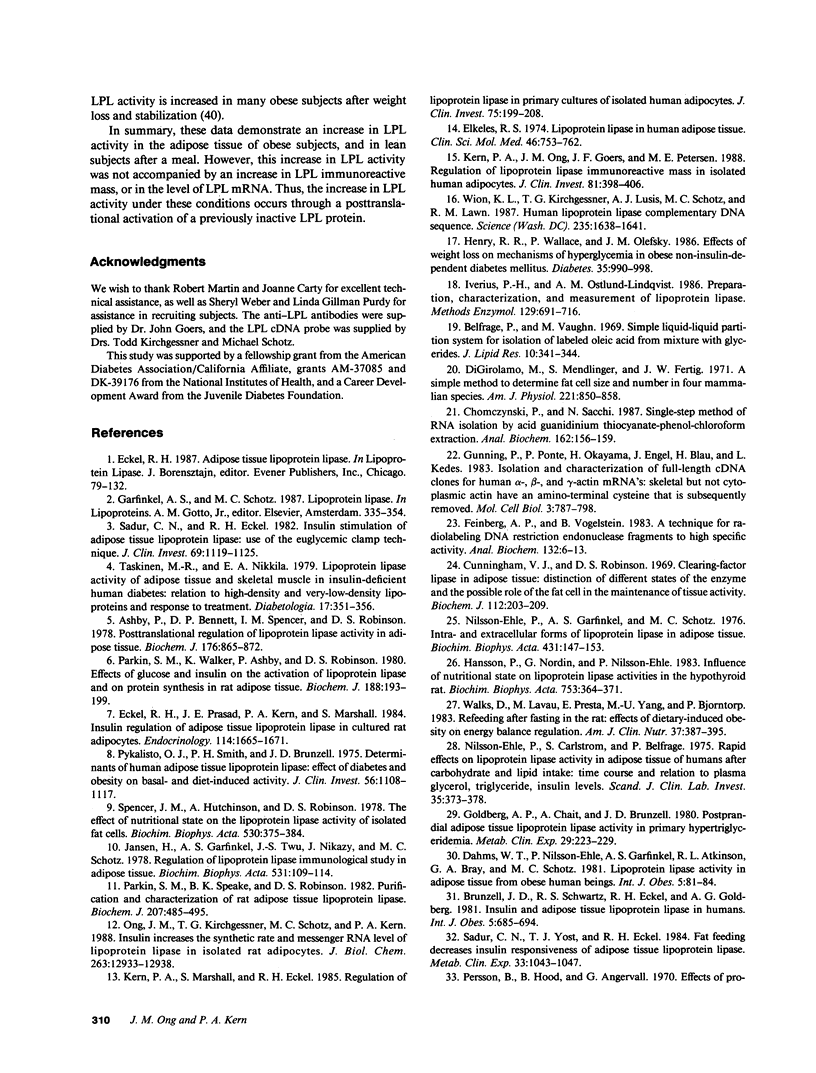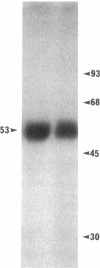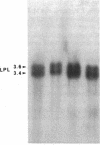Abstract
Previous studies have demonstrated higher levels of adipose tissue lipoprotein lipase (LPL) catalytic activity in obese subjects, and in response to a meal. To examine the cellular mechanism of this increase in activity, LPL activity, immunoreactive mass, and mRNA level were measured in lean and obese subjects both before and 4 h after a carbohydrate-rich meal. Heparin-releasable (HR) LPL activity was approximately 2.5-fold higher in the 15 obese subjects, when compared with six lean subjects. However, there was no difference in LPL immunoreactive mass between the lean and obese subjects. In response to the meal, there was a 2.2-fold increase in total adipose tissue LPL activity in the lean subjects due to an increase in both the HR fraction, as well as the adipose fraction extracted with detergents. However, no increase in LPL immunoreactive mass was observed in any adipose tissue LPL fraction, resulting in an increase in LPL specific activity in response to the meal. In the obese subjects, there was no significant increase in LPL activity in response to feeding, and also no increase in immunoreactive mass or specific activity. After extraction of RNA, there was no difference in either the relative proportion of the 3.6- and 3.4-kb human LPL mRNA transcripts, nor in the quantity of LPL mRNA in response to feeding. Thus, these data suggest that the increase in LPL activity under these conditions occurs through a posttranslational activation of a previously inactive LPL precursor.
Full text
PDF






Images in this article
Selected References
These references are in PubMed. This may not be the complete list of references from this article.
- Amri E. Z., Vannier C., Etienne J., Ailhaud G. Maturation and secretion of lipoprotein lipase in cultured adipose cells. II. Effects of tunicamycin on activation and secretion of the enzyme. Biochim Biophys Acta. 1986 Feb 12;875(2):334–343. doi: 10.1016/0005-2760(86)90184-0. [DOI] [PubMed] [Google Scholar]
- Ashby P., Bennett D. P., Spencer I. M., Robinson D. S. Post-translational regulation of lipoprotein lipase activity in adipose tissue. Biochem J. 1978 Dec 15;176(3):865–872. doi: 10.1042/bj1760865. [DOI] [PMC free article] [PubMed] [Google Scholar]
- Belfrage P., Vaughan M. Simple liquid-liquid partition system for isolation of labeled oleic acid from mixtures with glycerides. J Lipid Res. 1969 May;10(3):341–344. [PubMed] [Google Scholar]
- Brunzell J. D., Schwartz R. S., Eckel R. H., Goldberg A. P. Insulin and adipose tissue lipoprotein lipase activity in humans. Int J Obes. 1981;5(6):685–694. [PubMed] [Google Scholar]
- Chajek-Shaul T., Friedman G., Knobler H., Stein O., Etienne J., Stein Y. Importance of the different steps of glycosylation for the activity and secretion of lipoprotein lipase in rat preadipocytes studied with monensin and tunicamycin. Biochim Biophys Acta. 1985 Nov 14;837(2):123–134. doi: 10.1016/0005-2760(85)90235-8. [DOI] [PubMed] [Google Scholar]
- Chomczynski P., Sacchi N. Single-step method of RNA isolation by acid guanidinium thiocyanate-phenol-chloroform extraction. Anal Biochem. 1987 Apr;162(1):156–159. doi: 10.1006/abio.1987.9999. [DOI] [PubMed] [Google Scholar]
- Cunningham V. J., Robinson D. S. Clearing-factor lipase in adipose tissue. Distinction of different states of the enzyme and the possible role of the fat cell in the maintenance of tissue activity. Biochem J. 1969 Apr;112(2):203–209. doi: 10.1042/bj1120203. [DOI] [PMC free article] [PubMed] [Google Scholar]
- Dahms W. T., Nilsson-Ehle P., Garfinkel A. S., Atkinson R. L., Bray G. A., Schotz M. Lipoprotein lipase activity in adipose tissue from obese human beings. Int J Obes. 1981;5(1):81–84. [PubMed] [Google Scholar]
- Di Girolamo M., Mendlinger S., Fertig J. W. A simple method to determine fat cell size and number in four mammalian species. Am J Physiol. 1971 Sep;221(3):850–858. doi: 10.1152/ajplegacy.1971.221.3.850. [DOI] [PubMed] [Google Scholar]
- Eckel R. H., Prasad J. E., Kern P. A., Marshall S. Insulin regulation of lipoprotein lipase in cultured isolated rat adipocytes. Endocrinology. 1984 May;114(5):1665–1671. doi: 10.1210/endo-114-5-1665. [DOI] [PubMed] [Google Scholar]
- Elkeles R. S. Lipoprotein lipase in human adipose tissue. Clin Sci Mol Med. 1974 Jun;46(6):753–762. doi: 10.1042/cs0460753. [DOI] [PubMed] [Google Scholar]
- Feinberg A. P., Vogelstein B. A technique for radiolabeling DNA restriction endonuclease fragments to high specific activity. Anal Biochem. 1983 Jul 1;132(1):6–13. doi: 10.1016/0003-2697(83)90418-9. [DOI] [PubMed] [Google Scholar]
- Goldberg A. P., Chait A., Brunzell J. D. Postprandial adipose tissue lipoprotein lipase activity in primary hypertriglyceridemia. Metabolism. 1980 Mar;29(3):223–229. doi: 10.1016/0026-0495(80)90063-3. [DOI] [PubMed] [Google Scholar]
- Greenwood M. R. The relationship of enzyme activity to feeding behavior in rats: lipoprotein lipase as the metabolic gatekeeper. Int J Obes. 1985;9 (Suppl 1):67–70. [PubMed] [Google Scholar]
- Gunning P., Ponte P., Okayama H., Engel J., Blau H., Kedes L. Isolation and characterization of full-length cDNA clones for human alpha-, beta-, and gamma-actin mRNAs: skeletal but not cytoplasmic actins have an amino-terminal cysteine that is subsequently removed. Mol Cell Biol. 1983 May;3(5):787–795. doi: 10.1128/mcb.3.5.787. [DOI] [PMC free article] [PubMed] [Google Scholar]
- Hansson P., Nordin G., Nilsson-Ehle P. Influence of nutritional state on lipoprotein lipase activities in the hypothyroid rat. Biochim Biophys Acta. 1983 Oct 11;753(3):364–371. doi: 10.1016/0005-2760(83)90060-7. [DOI] [PubMed] [Google Scholar]
- Henry R. R., Wallace P., Olefsky J. M. Effects of weight loss on mechanisms of hyperglycemia in obese non-insulin-dependent diabetes mellitus. Diabetes. 1986 Sep;35(9):990–998. doi: 10.2337/diab.35.9.990. [DOI] [PubMed] [Google Scholar]
- Iverius P. H., Ostlund-Lindqvist A. M. Preparation, characterization, and measurement of lipoprotein lipase. Methods Enzymol. 1986;129:691–704. doi: 10.1016/0076-6879(86)29099-0. [DOI] [PubMed] [Google Scholar]
- Jansen H., Garfinkel A. S., Twu J. S., Nikazy J., Schotz M. C. Regulation of lipoprotein lipase immunological study of adipose tissue. Biochim Biophys Acta. 1978 Oct 25;531(1):109–114. doi: 10.1016/0005-2760(78)90187-x. [DOI] [PubMed] [Google Scholar]
- Kern P. A., Marshall S., Eckel R. H. Regulation of lipoprotein lipase in primary cultures of isolated human adipocytes. J Clin Invest. 1985 Jan;75(1):199–208. doi: 10.1172/JCI111675. [DOI] [PMC free article] [PubMed] [Google Scholar]
- Kern P. A., Ong J. M., Goers J. W., Pedersen M. E. Regulation of lipoprotein lipase immunoreactive mass in isolated human adipocytes. J Clin Invest. 1988 Feb;81(2):398–406. doi: 10.1172/JCI113332. [DOI] [PMC free article] [PubMed] [Google Scholar]
- Nilsson-Ehle P., Carlström S., Belfrage P. Rapid effect on lipoprotein lipase activity in adipose tissue of humans after carbohydrate and lipid intake. Scand J Clin Lab Invest. 1975 Jul;35(4):373–378. [PubMed] [Google Scholar]
- Nilsson-Ehle P., Garfinkel A. S., Schotz M. C. Intra- and extracellular forms of lipoprotein lipase in adipose tissue. Biochim Biophys Acta. 1976 Apr 22;431(1):147–156. doi: 10.1016/0005-2760(76)90269-1. [DOI] [PubMed] [Google Scholar]
- Olivecrona T., Chernick S. S., Bengtsson-Olivecrona G., Garrison M., Scow R. O. Synthesis and secretion of lipoprotein lipase in 3T3-L1 adipocytes. Demonstration of inactive forms of lipase in cells. J Biol Chem. 1987 Aug 5;262(22):10748–10759. [PubMed] [Google Scholar]
- Ong J. M., Kern P. A. The role of glucose and glycosylation in the regulation of lipoprotein lipase synthesis and secretion in rat adipocytes. J Biol Chem. 1989 Feb 25;264(6):3177–3182. [PubMed] [Google Scholar]
- Ong J. M., Kirchgessner T. G., Schotz M. C., Kern P. A. Insulin increases the synthetic rate and messenger RNA level of lipoprotein lipase in isolated rat adipocytes. J Biol Chem. 1988 Sep 15;263(26):12933–12938. [PubMed] [Google Scholar]
- Parkin S. M., Speake B. K., Robinson D. S. Purification and characterization of rat adipose tissue lipoprotein lipase. Biochem J. 1982 Dec 1;207(3):485–495. doi: 10.1042/bj2070485. [DOI] [PMC free article] [PubMed] [Google Scholar]
- Parkin S. M., Walker K., Ashby P., Robinson D. S. Effects of glucose and insulin on the activation of lipoprotin lipase and on protein-synthesis in rat adipose tissue. Biochem J. 1980 Apr 15;188(1):193–199. doi: 10.1042/bj1880193. [DOI] [PMC free article] [PubMed] [Google Scholar]
- Persson B., Hood B., Angervall G. Effects of prolonged fast on lipoprotein lipase activity eluted from human adipose tissue. Acta Med Scand. 1970 Sep;188(3):225–229. doi: 10.1111/j.0954-6820.1970.tb08030.x. [DOI] [PubMed] [Google Scholar]
- Pykälistö O. J., Smith P. H., Brunzell J. D. Determinants of human adipose tissue lipoprotein lipase. Effect of diabetes and obesity on basal- and diet-induced activity. J Clin Invest. 1975 Nov;56(5):1108–1117. doi: 10.1172/JCI108185. [DOI] [PMC free article] [PubMed] [Google Scholar]
- Sadur C. N., Eckel R. H. Insulin stimulation of adipose tissue lipoprotein lipase. Use of the euglycemic clamp technique. J Clin Invest. 1982 May;69(5):1119–1125. doi: 10.1172/JCI110547. [DOI] [PMC free article] [PubMed] [Google Scholar]
- Sadur C. N., Yost T. J., Eckel R. H. Fat feeding decreases insulin responsiveness of adipose tissue lipoprotein lipase. Metabolism. 1984 Nov;33(11):1043–1047. doi: 10.1016/0026-0495(84)90235-x. [DOI] [PubMed] [Google Scholar]
- Schwartz R. S., Brunzell J. D. Increase of adipose tissue lipoprotein lipase activity with weight loss. J Clin Invest. 1981 May;67(5):1425–1430. doi: 10.1172/JCI110171. [DOI] [PMC free article] [PubMed] [Google Scholar]
- Spencer I. M., Hutchinson A., Robinson D. S. The effect of nutritional state on the lipoprotein lipase activity of isolated fat cells. Biochim Biophys Acta. 1978 Sep 28;530(3):375–384. doi: 10.1016/0005-2760(78)90157-1. [DOI] [PubMed] [Google Scholar]
- Taskinen M. R., Nikkilä E. A. Lipoprotein lipase activity of adipose tissue and skeletal muscle in insulin-deficient human diabetes. Relation to high-density and very-low-density lipoproteins and response to treatment. Diabetologia. 1979 Dec;17(6):351–356. doi: 10.1007/BF01236268. [DOI] [PubMed] [Google Scholar]
- Vannier C., Amri E. Z., Etienne J., Négrel R., Ailhaud G. Maturation and secretion of lipoprotein lipase in cultured adipose cells. I. Intracellular activation of the enzyme. J Biol Chem. 1985 Apr 10;260(7):4424–4431. [PubMed] [Google Scholar]
- Walks D., Lavau M., Presta E., Yang M. U., Björntorp P. Refeeding after fasting in the rat: effects of dietary-induced obesity on energy balance regulation. Am J Clin Nutr. 1983 Mar;37(3):387–395. doi: 10.1093/ajcn/37.3.387. [DOI] [PubMed] [Google Scholar]
- Wion K. L., Kirchgessner T. G., Lusis A. J., Schotz M. C., Lawn R. M. Human lipoprotein lipase complementary DNA sequence. Science. 1987 Mar 27;235(4796):1638–1641. doi: 10.1126/science.3823907. [DOI] [PubMed] [Google Scholar]






